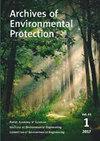First report on implementation of response surface methodology for the biodegradation of textile industrial effluents by Coniophora puteana IEBL-1
IF 1.3
4区 环境科学与生态学
Q4 ENVIRONMENTAL SCIENCES
引用次数: 2
Abstract
: The current study was aimed to evaluate the industrial ef fl uents biodegradation potential of an indigenous microorganism which reduced water pollution caused by these ef fl uents. In the present study biodegradation of three textile industrial ef fl uents was performed with locally isolated brown rot fungi named Coniophora puteana IEBL-1. Response Surface Methodology (RSM) was employed under Box Bhenken Design (BBD) for the optimization of physical and nutritional parameters for maximum biodegradation. Quality of treated ef fl uents was checked by study of BOD, COD and analysis through HPLC. Three ligninolytic enzymes named lignin peroxidase, manganese peroxidase and laccase were also studied during the biodegradation process. The results showed that there was more than 85% biodegradation achieved for all three ef fl uents with decrease in Biological Oxygen Demand (BOD) and Chemical Oxygen Demand (COD) below the recommended values for industrial ef fl uent i.e. 80 mg/L for BOD and 220 mg/L for COD after optimization of nutritional parameters in the second stage. Analysis of samples through HPLC revealed the formation of less toxic diphenylamine, 3-methyldiphenylamine and N-methylaniline after treatment. The ligninolytic enzymes assays con fi rmed the role of lignin peroxidase (LiP), manganese peroxidase响应面法在纺织工业废水生物降解中的应用研究
本研究旨在评价一种本地微生物对工业废水的生物降解潜力,以减少工业废水对水体的污染。利用当地分离的褐腐菌(Coniophora puteana iebl1)对3种纺织工业废水进行了生物降解研究。在Box henken设计(BBD)下,采用响应面法(RSM)优化物理和营养参数,以实现最大限度的生物降解。通过生化需氧量(BOD)、化学需氧量(COD)测定和高效液相色谱(HPLC)分析,对处理后的出水质量进行了检验。对木质素降解酶木质素过氧化物酶、锰过氧化物酶和漆酶进行了研究。结果表明:经第二阶段营养参数优化后,3种出水均达到85%以上的生物降解效果,生物需氧量(BOD)和化学需氧量(COD)均低于工业出水推荐值(BOD为80 mg/L, COD为220 mg/L)。经HPLC分析,样品经处理后形成毒性较小的二苯胺、3-甲基二苯胺和n -甲基苯胺。木质素分解酶测定证实了木质素过氧化物酶(LiP)、锰过氧化物酶的作用
本文章由计算机程序翻译,如有差异,请以英文原文为准。
求助全文
约1分钟内获得全文
求助全文
来源期刊

Archives of Environmental Protection
ENVIRONMENTAL SCIENCES-
CiteScore
2.70
自引率
26.70%
发文量
0
期刊介绍:
Archives of Environmental Protection is the oldest Polish scientific journal of international scope that publishes articles on engineering and environmental protection. The quarterly has been published by the Institute of Environmental Engineering, Polish Academy of Sciences since 1975. The journal has served as a forum for the exchange of views and ideas among scientists. It has become part of scientific life in Poland and abroad. The quarterly publishes the results of research and scientific inquiries by best specialists hereby becoming an important pillar of science. The journal facilitates better understanding of environmental risks to humans and ecosystems and it also shows the methods for their analysis as well as trends in the search of effective solutions to minimize these risks.
 求助内容:
求助内容: 应助结果提醒方式:
应助结果提醒方式:


